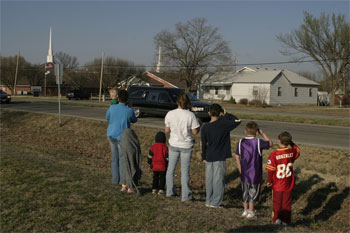I was in Ventura, Calif., teaching the Platypus Workshop, when I heard that Gordon Parks had died.
I always drive to California from my home in Austin, Texas. I looked at a map and decided that I could reroute my trip home through Ft. Scott, Kan., in time to attend the funeral service for Gordon, and his interment in the cemetery where his mother and father were buried.
I'm glad that I did.
 |
Residents of Fort Scott, Kan., watch as the hearse carrying the body of Gordon Parks passes by enroute to a cemetery on March 16, 2006. The three boys on the right (from left), Garrett Reynolds, Gavin Majors and Dalton Barnes, offer a respectful salute to Mr. Parks. Dirck Halstead |
I turned off Interstate 10 at Tucumcari, N.M., and headed east on Highway 54, cutting across eastern New Mexico, the sliver of Oklahoma, and then into Kansas. For the next eight hours I drove across the Plains. It was a sparkling early spring day. The wheat fields and ranches stretched out to the horizon under a vivid blue sky. I passed through towns dominated by white grain elevators. I stopped for lunch in Liberal, Kan., and had chicken fried steak in a family restaurant.
As I drove, it occurred to me that it was this heartland from which Gordon had drawn his strength: "... I used to sit and dream of what I wanted to become. I always return here weary, but to draw strength from this huge silence that surrounds me ...".
 |
Family and friends of Gordon Parks gather at graveside to bury him near his parents and siblings in Fort Scott, Kan., on March 16, 2006. Dirck Halstead |
Gordon was born in 1912. He dreamed big. He got his first big break photographing fashion for a department store in St. Paul, Minn. In the '40s, he joined Roy Stryker's legendary unit at the Farm Security Administration and later followed Stryker to the Standard Oil Photography Project, documenting small towns and industrial centers. Gordon joined
LIFE magazine in 1948, the first black photographer to be hired by the publication. He used his unique position to explain black America to the millions of readers of that magazine. Having reached the pinnacle of photojournalism, he wrote his first novel, "The Learning Tree," based on his experiences growing up in rural Kansas. He then went on to write and direct a film version of the book -- his first movie for Hollywood, and the first major studio feature film directed by an African-American. In 1971 he directed his second movie, "Shaft," an action-adventure film, in which the hero was black. Its success spawned a series of "blaxploitation" films. He worked closely with composer Isaac Hayes to compose one of the most famous themes in movie history. Then in his 60s, he just got better. He painted, wrote and composed, even creating a ballet inspired by Martin Luther King, Jr. In 1988 he was awarded the National Medal of Arts, one of the nation's highest civilian honors.
 |
One of several billboards leading into Fort Scott, Kan., Gordon Parks' birthplace and, now, final resting place. In appreciation of their favorite son, Fort Scott residents raised $900 to place them on the highway into town. Dirck Halstead |
Yet for most of his life, he turned his back on Ft. Scott. He bitterly remembered the discrimination he had to endure as a child in this small, segregated Kansas town "electrified with racial tension." But in the 1990s, the town reached out to its favorite son. Signs reading "Ft. Scott, Childhood Home of Gordon Parks" were erected alongside the highway. This got his attention. In the last years of his life he returned the affection, and embraced his Midwestern roots. In his honor, the Gordon Parks Elementary School was created in 1999 in midtown Kansas City, Mo., to educate urban-core children. And with the proud urging of Ft. Scott's townspeople, the first Gordon Parks Celebration of Culture and Diversity, a four-day event, brought him back to his hometown in October 2004.
As he was dying in New York, Gordon told his son David that he wished to be taken "home" to Ft. Scott to be buried next to his parents and siblings.
I thought about this, as I was driving under the limitless skies of rural Kansas. I began to understand that it was this land of forever horizons that had inspired him as a young man, and had given him room to hope and dream large.
I close with these photographs from Gordon Parks' funeral in Ft. Scott. In the end, he came home to his roots. The land, which he loved so much, and the people will survive, and take note of his passing.
I am a citizen of America. I ache for the many problems we face. But when I think about the continuity of the dream that Gordon Parks witnessed over his 93 years, I take heart, and thank God for my good fortune.




